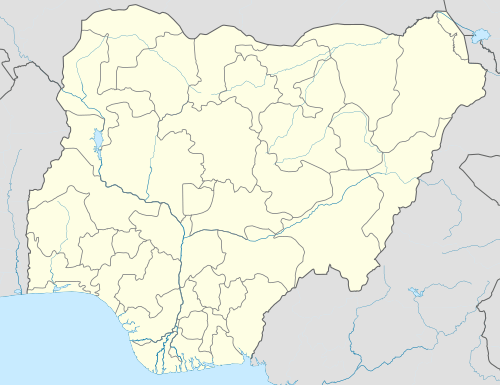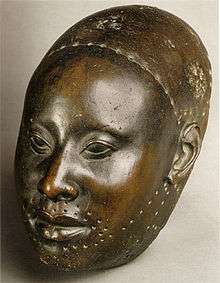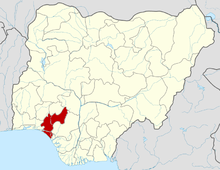Owo
Owo is a city in Ondo State of Nigeria. Between 1400 and 1600 AD, it was the capital of a Yoruba city-state. The local government has a population of 222,262, based on 2006 population census.
Owo Ogho Imade | |
|---|---|
LGA | |
 Owo | |
| Coordinates: 7°11′N 5°35′E | |
| Country | Nigeria |
| State | Ondo State |
| Time zone | UTC+1 (WAT) |
| Climate | Aw |
| Total population | |
|---|---|
| ~ 425,700 (2011) | |
| Regions with significant populations | |
| Ondo State - 425,700 · Owo Local Government: 258,230 · Ose Local Government: 167,470 | |
| Religion | |
| Christianity · Yoruba religion · Islam |
History
| Part of a series on |
| Yoruba people |
|---|
 |
| Subgroups |
| Music |
|
Contemporary: Folk/Traditional: |
| Notable personalities |
| List of Yoruba people |
| Religion |
| Diaspora |
|
| Festivals and events |
|
West Africa:
Diaspora:
|
In their oral tradition, Owo traces its origins back to the ancient city of Ile-Ife, the cradle of Yoruba culture.[1] Oral tradition also claims that the founders were the sons of the Yoruba deity Odudua, who was the first ruler of Ile-Ife. The early art-historical and archaeological records reinforce these strong affiliations with Ife culture.[1] Owo was able to maintain virtual independence from the neighboring kingdom of Benin, but was on occasion required to give tribute.[2] The transmission of courtly culture flowed in both directions between the Benin and the Owo kingdoms. The skill of Owo's ivory carvers was also appreciated at the court of Benin. During the seventeenth and eighteenth centuries, Benin's rulers increasingly utilized insignia made from ivory, and imported Owo's art objects and recruited its artisans for their own royal workshops.[3] There were other notable artworks that can be evidently supported.[4]
Owo came under British rule in 1893. After Nigeria declared independence in 1960, it was part of the Western Region until 1967 when it became part of the Western State. Owo and its indigenes played significant roles in the politics of the first Republic in Nigeria. In 1976, it became part of the newly created Ondo State.
The Palace of the Olowo of Owo is the largest Palace in Africa.
Culture
Owo has the largest palace (Aghofen) in Africa which was declared a national monument by the federal government. The Olowo Palace had as many as 100 courtyards (Ugha). Each courtyard had a specific function and was dedicated to a particular deity. The largest, said to have been twice the size of an American football field, was used for public assemblies and festivals. Some courtyards were paved with quartz pebbles or broken pottery. Pillars supporting the veranda roofs were carved with statues of the king mounted on a horse or shown with his senior wife. The most recent Olowo was Oba Folagbade Olateru Olagbegi III.
Economy
The present-day city is an agricultural center involved in the growing and trade of yams, cassava, maize, okra, peppers, cocoa, and cotton. There are, however, other meaningful commercial activities in the town, including but not limited to: timber and sawmilling, Soya bean processing plants and blockmaking industries. The town is dotted with branches of some of the foremost banks like, First Bank Plc, Wema Bank Plc, Skye Bank Plc, Enterprise Bank Ltd. (formerly Omega Bank Plc), etc. The city is now witnessing a dramatic change due to expansion of its road network, particularly dualization of the main road beginning from Emure junction up to Iyere exit. A new ultra-modern market is now open in Owo.
Geography
Owo is situated in south-western Nigeria, at the southern edge of the Yoruba Hills, and at the intersection of roads from Akure, Kabba, Benin City, and Siluko. Owo is situated halfway between the towns of Ile Ife and Benin City.
Archaeology
The Owo site was first excavated in 1969–1971 by Ekpo Eyo under the auspices of the Department of Antiquities of the Government of Nigeria. Due to Owo's location between the two famous art centers of Ife and Benin, the site reflects both artistic traditions. Important discoveries include terracotta sculptures dating from the 15th century. The Owo Museum, founded in 1968, houses many of these artifacts.
Traditional rulers
- Sir Olateru Olagbegi II (1941–1968 and 1993–1998). He was dethroned in 1968 and reinstated in 1993.
- Adekola Ogunoye II (February 1968 – November 1992)
- Folagbade Olateru Olagbegi III (1999 – April 2019)
- Gbadegesin Ajibade Ogunoye (since 12 July 2019).[5]
See also
References
- "Origins and Empire: The Benin, Owo, and Ijebu Kingdoms". metmuseum.org. Retrieved 13 December 2013.
- Smith (1988), Kingdoms of the Yoruba, p. 52.
- "Exchange of Art and Ideas: The Benin, Owo, and Ijebu Kingdoms". metmuseum.org. Retrieved 13 December 2013.
- Roll of Owo carvershttp://www.jstor.org/stable/2798654
- https://pmparrotng.com/2019/07/13/olowo-of-owo-how-ajibade-gbadegesin-ogunoye-emerged/
Bibliography
- Smith, Robert Sydney (1988), Kingdoms of the Yoruba, (Madison: University of Wisconsin Press, 3rd ed.).
- Weisser, Gabriele (2008), Das Königtum der Owo-Yoruba: Zwischen Mythologie und Geschichte, (Hamburg, Kovac). (The kingdom of the Owo-Yoruba: Between Mythology and History).
